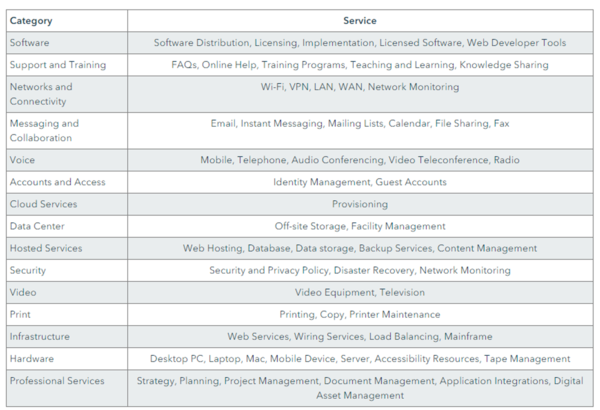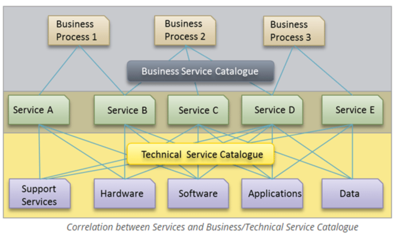Difference between revisions of "Service Catalog"
| Line 21: | Line 21: | ||
[[File:Service Pipeline.png|400px|Service Pipeline]]<br /> | [[File:Service Pipeline.png|400px|Service Pipeline]]<br /> | ||
source: [https://www.itilnews.com/index.php?pagename=ITIL_V3_Service_Portfolio_and_Lifecycle ITIL News] | source: [https://www.itilnews.com/index.php?pagename=ITIL_V3_Service_Portfolio_and_Lifecycle ITIL News] | ||
| + | |||
| + | |||
| + | '''Service Catalogue - Different Approaches<ref>What are the Two Types of Service Catalogue? [https://advisera.com/20000academy/blog/2013/03/19/service-catalogue-window-world/ Advisera]</ref>'''<br /> | ||
| + | Practically, there are two kinds of Service Catalogue for a Service: | ||
| + | *Business Service Catalogue. If we are considering (potential) customers and what we offer (our Service Catalogue), then we are talking about Business Service Catalogue. Services that we offer are written in clear, easily understandable (as much as it is possible) or, as we like to say, business language. Usually, that is hard job to do as well as a reason why it is hard to establish a Service Catalogue for an organization. Sometimes I find that people involved in the development of a Service Catalogue are too technical, and the result is that the Service Catalogue is written too technical; but, if they do not have technical knowledge, it is hard to understand a detailed description of a service (which is a prerequisite to make a short and understandable summary). | ||
| + | *Technical Service Catalogue. On the other side, Services have a lot of technology in their backgrounds. A technological solution has to be documented and explained in detail: that is the Technical Service Catalogue. It is written in technical language and is not intended to be published outside of the IT organization, i.e. customers don’t need to have access to such a document. Its value is in defining end-to-end service from a technical point of view. | ||
| + | |||
| + | |||
| + | [[File:Business and Technical Service Catalogue.png|400px|Business and Technical Service Catalogue]]<br /> | ||
| + | source: Advisera | ||
| + | |||
| + | |||
| + | What usually happens is that organizations have a Business Service Catalogue, but rarely have a Technical Service Catalogue. Typically, the Technical Service Catalogue is usually presented via the functional specification of a service. If there is no other possibility, that is okay, but the Technical Service Catalogue should also contain information from other processes of a service lifecycle (e.g. Service Level Agreement data from Service Level Management process). | ||
| + | |||
| + | Typical content of a Business Service Catalogue includes deliverable description (services that we are offering, written in business language), service level parameters, costs, maintenance description, information about related services, description of the value that is provided to the customer, etc. | ||
Revision as of 14:33, 24 March 2021
An ITIL Service Catalog (or Service Catalogue) is the single source of accurate information on all IT services offered by an organization's IT department. ITIL defines a service catalog as a centralized database of accurate information about active IT service offerings, and a subset of the IT service provider's service portfolio. In simpler terms, it is the storefront from where end users (internal or external) request services and products from the IT service desk based on the information provided in the service catalog.[1]
Developing a Service Catalog[2]
Developing a service catalog may sound simple, but in order to encourage customer engagement and set proper expectations, it helps to consider the following tips to make it work:
- Identify the services your business needs in order to operate: Developing a service catalog is an exercise in good communication. Know your company and learn about its wants and needs. Business unit managers and other decision makers should work with both end users and stakeholders to determine what they need to perform their jobs. Differentiate between the services that your service desk and other IT teams currently provide and what may be missing. Are they essential and, more importantly, do they align with company goals?
- Define security and access permissions: Who will have access to the service catalog and specific services? Restricting access to the service catalog or specific services is important. You may want to allow end-users to request a keyboard or mouse, but limit items with a higher price tag, such as laptops or tablets, to management.
- Simplify the search process: Categorize services with your end user in mind. Simplify whenever possible and keep technical jargon to a minimum. For example, would a business user know to look under ‘infrastructure’ for backup services, or should ‘backup’ be front and center? Think about the intuitiveness of Amazon categorization. Confusion creates dissatisfaction, and dissatisfaction will defeat the purpose of your service catalog.
- Optimize the user experience: Make the user experience a friendly one with an easy-to-access, simple-to-navigate IT self-service portal that contains all of the services that they will need to do their job.
- Roll out in phases: Test a representative portion of your user pool with a small selection of services. Find out what works and what doesn’t. Solve the “glitches” and slowly increase the user base and offerings within your catalog.
- Invest in automation: Once you feel confident in the design of your service catalog and processes that support it, select a software product that best manages your company’s specific service needs – and automate delivery whenever possible.
The figure below illustrates where the Service Catalog fits in the Service Lifecycle.

source: ITIL News
Service Catalogue - Different Approaches[3]
Practically, there are two kinds of Service Catalogue for a Service:
- Business Service Catalogue. If we are considering (potential) customers and what we offer (our Service Catalogue), then we are talking about Business Service Catalogue. Services that we offer are written in clear, easily understandable (as much as it is possible) or, as we like to say, business language. Usually, that is hard job to do as well as a reason why it is hard to establish a Service Catalogue for an organization. Sometimes I find that people involved in the development of a Service Catalogue are too technical, and the result is that the Service Catalogue is written too technical; but, if they do not have technical knowledge, it is hard to understand a detailed description of a service (which is a prerequisite to make a short and understandable summary).
- Technical Service Catalogue. On the other side, Services have a lot of technology in their backgrounds. A technological solution has to be documented and explained in detail: that is the Technical Service Catalogue. It is written in technical language and is not intended to be published outside of the IT organization, i.e. customers don’t need to have access to such a document. Its value is in defining end-to-end service from a technical point of view.
What usually happens is that organizations have a Business Service Catalogue, but rarely have a Technical Service Catalogue. Typically, the Technical Service Catalogue is usually presented via the functional specification of a service. If there is no other possibility, that is okay, but the Technical Service Catalogue should also contain information from other processes of a service lifecycle (e.g. Service Level Agreement data from Service Level Management process).
Typical content of a Business Service Catalogue includes deliverable description (services that we are offering, written in business language), service level parameters, costs, maintenance description, information about related services, description of the value that is provided to the customer, etc.
See Also
ITIL (Information Technology Infrastructure Library)
ITIL Availability Management
ITIL Continual Service Improvement (CSI)
ITIL Event Management
ITIL Facilities Management
ITIL Problem Management
ITIL Service Delivery
ITIL Service Design
ITIL Service Lifecycle
ITIL Service Strategy
ITIL Service Operation
ITIL Service Value Chain (SVC)
ITIL Service Value System (SVS)
Service Portfolio Management
Service Portfolio
Service Catalog
IT Governance
IT Infrastructure
IT Operations (Information Technology Operations)
Control Objectives for Information and Related Technology (COBIT)
Balanced Scorecard
Enterprise Risk Management (ERM)
Risk Management
IT Strategy
Business Strategy
Corporate Governance
Corporate Strategy
Enterprise Architecture
COSO Internal Control- Integrated Framework
Compliance
References
See Also
ITIL (Information Technology Infrastructure Library)
ITIL Availability Management
ITIL Continual Service Improvement (CSI)
ITIL Event Management
ITIL Facilities Management
ITIL Problem Management
ITIL Service Delivery
ITIL Service Design
ITIL Service Lifecycle
ITIL Service Strategy
ITIL Service Operation
ITIL Service Value Chain (SVC)
ITIL Service Value System (SVS)
Service Portfolio Management
Service Portfolio
Service Catalog Management
IT Governance
IT Infrastructure
IT Operations (Information Technology Operations)
Control Objectives for Information and Related Technology (COBIT)
Balanced Scorecard
Enterprise Risk Management (ERM)
Risk Management
IT Strategy
Business Strategy
Corporate Governance
Corporate Strategy
Enterprise Architecture
COSO Internal Control- Integrated Framework
Compliance


